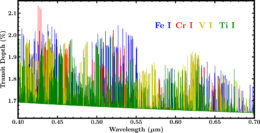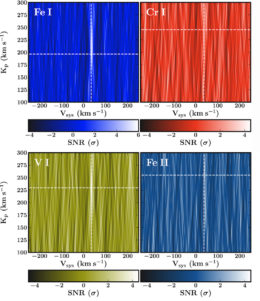With atmospheric temperatures ranging from roughly 3,000 to 6,500 degrees Fahrenheit, ultra-hot Jupiters are ready-made laboratories for extreme planetary science. For instance, any molecules in the atmosphere of an ultra-hot Jupiter will be broken down into their component atoms and ions. So what can be found in the atmosphere of the ultra-hot Jupiter WASP-121 b?
Laboratories for Extreme Science
Ultra-hot Jupiters (UHJs) are unlike any planet in our solar system. They are massive, yet they live very close to their host stars. This proximity causes many unusual phenomena, such as chemical variations between the planet’s daysides and nightsides.The intense heat UHJs experience also leads to their atmospheric components breaking down. Various metal atoms and ions have been identified in the atmospheres of UHJs, including neutral sodium, iron, and magnesium, and ionized titanium and calcium. However, more neutral metals ought to be detected, especially in the lower parts of these planets’ atmospheres.
Knowing which metals to expect in a UHJ would greatly aid observations and the classification of these planets. To this end, a group of researchers led by Maya Ben-Yami (University of Cambridge, UK) attempted to predict what metals could be found in the atmosphere of the UHJ WASP-121 b and then compared their results to observations of the planet.

The model transmission spectra of WASP-121 b based on the contributions from neutral iron, chromium, vanadium, and titanium. Click to enlarge. [Ben-Yami et al. 2020]
Creating a Metal Metric
WASP-121 b has been the subject of many studies over the past few years. It orbits its host star every 1.3 days and is roughly the mass of Jupiter. It’s a good candidate for transmission spectroscopy — looking at light from the host star filtered through a planet’s atmosphere to learn about the atmospheric composition — since it’s large and its host is very bright.
Ben-Yami and collaborators began their analysis by modeling atomic abundances for WASP-121 b. They then used these abundances to understand how strongly the signature of a metal would appear in a spectrum. After accounting for effects like stellar rotation, the end result is a model transmission spectrum for WASP-121 b.
With a model spectrum in hand, Ben-Yami and collaborators were then able to quantify how likely it was for a metal to show up in an observed spectrum of WASP-121 b. Assuming a reasonable spectrum quality and signal noise, they found that the most likely neutral metals to be observed in WASP-121 b would be iron, titanium, vanadium, and chromium.
Functional Metal Detectors

From left to right and top to bottom, the detections of neutral iron, neutral chromium, neutral vanadium, and ionized iron. The dashed white lines indicate where an applied template picked up the strongest signal, which, if significant enough, would be a detection. Vsys is related to the velocity of the host star. Kp quantifies the effect a planet has on its host star’s motion. [Adapted from Ben-Yami et al. 2020]
These detections and non-detections provide insight into the role of vanadium oxide and titanium oxide in UHJs. Both molecules are believed to cause deviations from the expected relation between altitude and temperature. The detection of neutral vanadium suggests that vanadium oxide gets broken down while the non-detection of neutral titanium suggests the opposite is true for titanium oxide.
Aside from the new detections of neutral vanadium and chromium, this study suggests that it is viable to probe the lower atmospheres of UHJs using model-based metrics and high quality spectra. With WASP-121 b being on the cooler side, there remains a large variety of UHJs left to characterize.
Citation
“Neutral Cr and V in the Atmosphere of Ultra-hot Jupiter WASP-121 b,” Maya Ben-Yami et al 2020 ApJL 897 L5. doi:10.3847/2041-8213/ab94aa



3 Comments
Pingback: From AAS NOVA: “There’s Metal in the Air” | sciencesprings
Pingback: Há metal no ar – Centro Ciência Viva do Algarve
Pingback: Extrém bolygókutatás ultraforró jupiterekkel – Könyv Kuckó